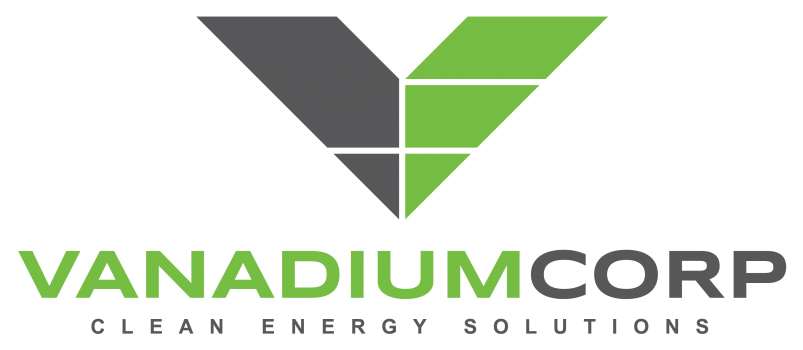Vancouver, British Columbia – April 24, 2024 – VanadiumCorp Resource Inc.…
VanadiumCorp Applauds California, USA for New Solar Requirement
![]()
VANCOUVER, BRITISH COLUMBIA – May 10, 2018. VanadiumCorp Resource Inc. (TSX-V: “VRB”) (the “Company”) applauds California’s new solar requirement as it will foster increased demand for vanadium-based energy storage. On May 9th, California became the first state in the U.S. to require solar panels on almost all new homes. Most new units built after Jan. 1, 2020, will be required to include solar systems as part of the standards adopted by the California Energy Commission.
Adriaan Bakker, CEO of VanadiumCorp states, “As energy storage costs drop in line with renewable energy, vanadium batteries are a perfect solution for storing residential to utility-scale energy. VanadiumCorp’s technology and resource development are focused on cost and carbon footprint mitigation for vanadium resulting in energy storage without a carbon footprint. Competing technologies like lithium have a short lifespan and a large carbon footprint while vanadium is a green reusable metal that is 100% sustainable with VanadiumCorp-Electrochem technology. Many jurisdictions in the world are instituting new legislation banning lithium battery installations in homes and commercial buildings due to safety concerns about fire.”
Because lithium batteries only have enough capacity for a few hours of electricity, they cannot run a standard American home for multiple days but can provide you with temporary backup power. They can also be calibrated so that they only power essentials in the event of a blackout, which can extend their usefulness. If you truly want to go completely off-grid, you have that option with vanadium batteries that have no fire risk and do not have to be installed in bunker-like lithium.
Solar panels produce more electricity during the long days of summer than they do in the winter months. To go completely off the grid, you will need a battery system that can store significant amounts of extra energy in the summer months so that you can meet your electricity needs in the winter. A typical home battery isn’t nearly large enough to do that – vanadium batteries are designed to provide many hours of renewable energy so that you can maximize your hour-by-hour solar electricity use.
The new legislation in California, already the nation’s largest solar market underpins how rooftop solar is becoming a mainstream energy source. The housing mandate is part of Governor Jerry Brown’s effort to slash carbon emissions by 40 percent by 2030 and offers an example for others to follow.
“This is massive,” said Morten Lund, chair of an energy storage initiative at law firm Stoel Rives LLP. “Essentially, this could turn residential solar into an appliance, like a water heater. There has always been a certain inevitability about that outcome, but this is moving faster than most of us thought likely.”
The U.S. residential solar market has increased more than six-fold to 10.4 gigawatts from five years ago. The industry started slowing in 2017 amid policy changes and efforts by some companies to shift their strategies. “Adoption of these standards represents a quantum leap in statewide building standards,” Bob Raymer, senior engineer of the California Building Industry Association, said during the meeting before the vote. “You can bet the other 49 states will be watching closely what happens.”
Solar Demand
California state adds about 80,000 new homes a year, and the California Solar & Storage Association estimates that about 15,000 include solar power. The Energy Commission says that the average home system uses 2.5 kilowatts to 4 kilowatts of panels, so the additional 65,000 new systems would add as much as 260 megawatts of annual demand in the state — about the size of one large solar farm. SunPower expects the rule will increase demand for residential solar in the state by about 50 percent.
Energy Storage Demand
Bloomberg New Energy Finance forecasts the global energy storage market will “double six times” by 2030, growing from less than 5 gigawatt-hours in 2016 to more than 300 gigawatt-hours. An estimated $103 billion will be invested in energy storage over that time period. A recent report from ResearchandMarkets.com estimates the opportunity for flow batteries to reach $230.2 million in 2018 and $946.3 million within 5 years, delivering a 32.7% CAGR. This anticipated market growth reflects an investment in renewable energy, the advantages of flow batteries, and utility demand for solutions.
According to the authors: With electric infrastructure and the growing need for higher energy capacity and production, modernization of grid system has become essential worldwide. Also, increasing penetration of renewable energy across the grid has, in turn, increased the need for efficient, flexible, and long operating life energy storage solutions. A flow battery, with all its attractive features, has become the most preferred energy storage technology for utility-based storage, as large-scale utilities require technologies that can cost-effectively store renewable energy for future grid-use at any location.
With vanadium flow batteries the most mature and most widely adopted option, vanadium currently holds a larger share of the flow battery market than other options such as zinc-bromide. Worldwide, more than 100 vanadium flow batteries have been installed for a variety of applications, including grid, commercial, military, microgrid, telecommunications, and EV charging stations.
North America, led by the United States, represents a strong opportunity for vanadium flow batteries to support energy storage, according to a recent news summary on SeekingAlpha.com, which noted: Energy storage in the United States was up +46% in the third quarter of 2017, the most recent data available. Three states — Massachusetts, California, and Hawaii — have targeted 2045 as the year to be 100% powered by renewable energy. As the shift toward renewables increases the demand for storage solutions, vanadium batteries, with proven reliability and longer life, may begin to outpace lithium as early as 2018 in the utility sector.
On behalf of the board:
Adriaan Bakker, President and Chief Executive Officer
For more information, contact Vanadiumcorp:
Adriaan Bakker, President, CEO
By phone: 604-385-4489
By email: moc.procmuidanav@ba
Website: www.vanadiumcorp.com
Neither the TSX Venture Exchange nor its Regulation Services Provider (as that term is defined in the policies of the TSX Venture Exchange) accepts responsibility for the adequacy or accuracy of this release.


